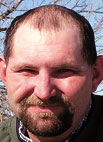
With the help of one full-time employee, John McDowell runs a cow/calf operation, as well as stocker calves. He also sells USDA-inspected beef straight from his Dade County farm.
When it comes to raising cattle, John McDowell knows a thing or two.
The lifelong cattleman runs a multifaceted operation of stocker cattle, cow/calf pairs and USDA-inspected beef at his Dade County, Mo., farm.
Cow/Calf pairs
On the cow/calf side of the operation, John runs about 400 pairs at his farm near South Greenfield. Females are a mixed herd and about a decade ago he began to incorporate Red Angus bulls.
“I’ve had other bulls before I got the Red Angus, but they are more consistent and I like the way the Red Angus breeders have stayed true to the cause and not chased a fad.”
The Red Angus Association has honored John with three Grind Master Awards. The award is earned by operations that have successfully combined high-performing Red Angus genetics, skillful feeding and precise marketing to achieve success with the slaughter of superior beef carcasses. In 2016, his naturally-fed Red Angus cattle were required to achieve 90 percent Choice and Prime, with no more than 10 percent Yield Grade 4s and a minimum grid score of 100. Two of McDowell’s loads went 100 percent Choice.
“The Red Angus is what has made the difference,” John said.
He currently runs about 14 bulls with his herd, which is split into spring and fall calving.
“We try to keep them pretty even,” John said. “We retain most of our females and that Red Angus is making them more uniform, which is what I want. Some of the purebred cattle out there aren’t as good as the commercial cattle, and the reason that is, and I’m still learning, some of the registered people chase the wrong things. They chased size for too long; we don’t need a 1,500-pound cow. I don’t need a 1,300-pound cow. I will take that 1,000- to 1,200-pound cow and raise a 500-pound calf.”
Calves are weaned at about 8 months of age. He retains about 60 or 70 heifers from each calving season, then sells the majority as bred heifers, which are bred at about 15 or 16 months of age.
Stockers
In his stocker operation, John’s calves, as well as calves he purchases from area stockyards and local farmers, will remain in feeding pens until they are ready for pasture or the feed yard.
Calves are housed in 17 lots, each with a watering system and feed bunks. Each pen also has a shaded area, where round bales are placed. John said the shade not only gives the cattle a cool spot in the summer months, it also allows the hay to stay dry and gives cattle protection from rain and snow.
John added he keeps the number of calves in each lot small so they can also take advantage of grasses that grow there.
He can run more than 700 head in the facility, which was built by his late brother, but opts to keep numbers low. He’s currently at about 500 head.
“I like to rotate them,” John said. “My brother kept 2,000 head and all of the pens were dirt. Keeping fewer calve helps reduces chances of disease and we don’t have the soil erosion.”
Stockers are fed a mix of feeds, including oats, barley sprouts, distillers grain, corn and wet coffee grounds. A high-protein liquid from Pro Energy Feeds is also added and mixed at the farm. Calves, as well as all cattle, are also offered the liquid supplement free choice. John strives for about 2 1/2 pounds of gain a day with the stocker calves.
Stockers are typically sold to a buyer at about 750 to 800 pounds, but he does sell at area stockyards as well.
Meat sales
John sells beef directly from the farm. Animals are processed at Golden City Meats in Golden City, Mo.
Cattle for the meat program are pulled from both his stocker and cow/calf operations. No matter the breed, animals selected for the program are of the highest quality.
“The good steers from our Red Angus we raise will go into the meat program,” he said, adding that heifers not meeting his criteria for breeding, including sufficient pelvic measurements, go into the beef or stocker programs.
He added that all calves in his meat program are antibiotic-free. Calves receiving an antibiotic treatment are sold with the stocker calves.
John’s farming operations at McDowell Land and Cattle may vary, but there are several consistencies in the practices.
John is a firm believer in raising his cattle as naturally as possible, which includes limited vaccinations.
“I try not to run my cows through the chute,” he said. “I think it’s stressful. I’m leaning more towards those cows that have been around 10, 12 years and don’t need a shot; they have had that vaccine and have that immunity.”
Calves are fully vaccinated, however, at weaning then an additional round.
“I also don’t like hauling my cattle around too much,” he said. “Every time you load a cow and move her, I think it takes years off her life.”
John is also adamant about soil health and quality forages, never allowing overgrazing on his 1,250-acre spread. He has incorporated a 12-variety forage system, which includes hairy vetch chicory, three types of clover, two oat varieties, wheat and barley.
“I’m a soil caretaker. I don’t kill my weeds with chemicals; I let the frost kill them,” he said. “I also don’t use any commercial fertilizers. The only thing we use is litter. I think we need to do everything we can do to make things like God wanted. God made it all and we just need to do a better job taking care of it. Every time you drive by a pasture that looks smooth like a pool table, you’re losing soil.







